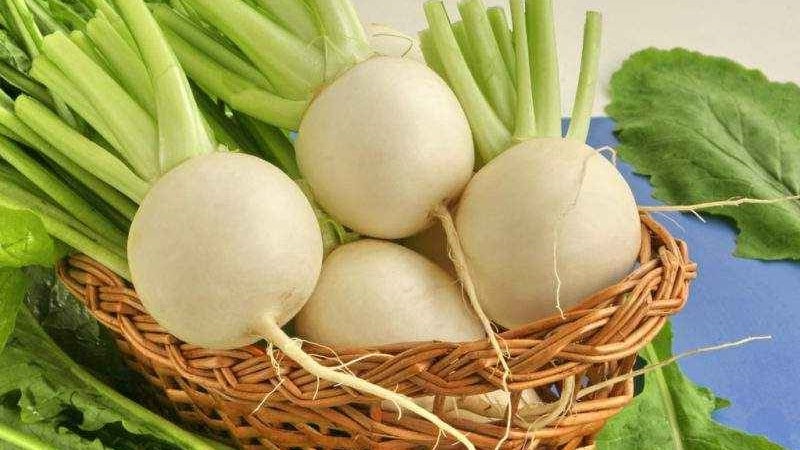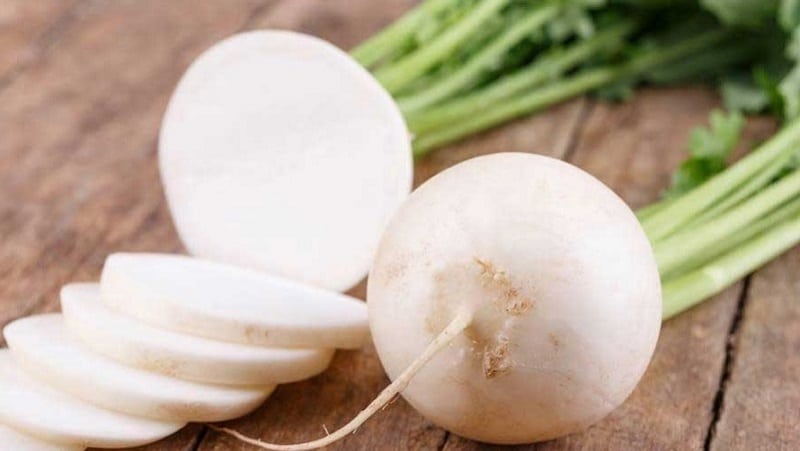The benefits and possible harm of turnips for a woman’s body
Turnip is a valuable vegetable, containing a large amount of vitamins and minerals. Healthy and tasty dishes are prepared from it, health-promoting infusions and healing ointments, masks for skin and hair are made. The root vegetable helps with various diseases. Let's get acquainted with the beneficial properties of turnips for a woman's health and study the contraindications.
Chemical composition and nutritional value of turnips
Turnips contain a large amount of vitamins:
- A (retinol);
- B1 (thiamine);
- B2 (riboflavin);
- B3 (vitamin PP, niacin);
- B5 (pantothenic acid);
- B6 (pyridoxine);
- C (ascorbic acid).

There are many minerals:
- potassium;
- calcium;
- silicon;
- phosphorus;
- gland;
- magnesium;
- boron;
- manganese;
- sulfur.
Nutritional value of turnips:
- Carbohydrates (fiber, starch, sugars). There are 6.2 g per 100 g of raw vegetable. When cooked, the carbohydrate content drops slightly (to 5 g).
- Squirrels. About 1.5 g per 100 g of raw product. Cooked - 0.71 g.
- Fats. There are the fewest of them, no more than 0.1 g per 100 g of turnip. In thermally processed vegetables, the fat content drops to 0.08 g.
Calorie content of turnips: 32 kcal per 100 g fresh and 22 kcal when cooked.
The benefits of turnips for a woman’s body
The vitamins and minerals contained in turnips help restore strength. The root vegetable has anti-inflammatory, diuretic and antioxidant properties, protects the liver and kidneys, reduces blood pressure, and prevents the development of diabetes and oncology.
During pregnancy
Turnip helps in the treatment of sore throat and hoarseness, relieves asthmatic attacks, has analgesic and disinfecting properties, and is used as a preventive and therapeutic agent for colds. The vegetable supports the health of the mother and helps the normal development of the fetus.
Attention! It is important for pregnant women to consume turnips with caution, in small quantities, monitoring the body’s reaction. If you have an allergy, it is better to avoid the product.
Due to its high calcium content, the vegetable serves as a preventive measure for diseases of the skeletal system and blood.
Can a nursing mother have turnips?
During lactation, the vegetable can be included in dietary dishes, but the taste of breast milk may change, so you should not overuse the root vegetable.
In the first few months after the baby is born eat turnips very carefully, monitoring the baby’s condition, since the vegetable can cause an allergic reaction or colic in a fragile body.
Beneficial properties of turnips during breastfeeding:
- assistance in the functioning of the immune system and treatment of colds;
- saturating the body with vitamins and minerals;
- improves digestion and relieves constipation;
- relieving swelling due to the diuretic effect;
- anti-inflammatory and analgesic effects;
- help in the fight against excess weight due to low calorie content;
- prevention of gastritis and pancreatitis;
- relieving nervous excitement, migraines;
- getting rid of insomnia.

The use of turnips in folk medicine and cosmetology
Turnips are often used in folk recipes to treat various diseases. The vitamins and minerals it contains have a beneficial effect on the skin and hair, which is why the vegetable is used in cosmetology.
How and for what diseases it is used
Strengthening, wound-healing, analgesic and soothing decoctions and ointments are prepared from the root vegetable.
For colds and coughs
Vegetable helps reduce temperature, has expectorant and anti-inflammatory effects. Helps thin mucus and relieve dry cough.
Directions for use:
- Squeeze the juice out of the finely grated root vegetable through a sieve. Pour the liquid into a small container and bring to a boil in a water bath. Cool the broth, add honey. Take 1 tbsp. l. 4 times a day.
- Place the peeled and chopped vegetable into small pieces into a jar of a suitable size and fill it with boiling water to the top. Infuse the product for 6 hours. Take 3 times a day, 2 tbsp. l.
From high blood pressure
Eating the vegetable raw or cooked is beneficial for high blood pressure.
Attention! Turnip juice stimulates cardiac activity, so if you have cardiovascular diseases, it is important to consult your doctor about the possibility of consuming the vegetable.
Mode of application:
- Consumed fresh (pulp or juice).
- Steaming. Cook until the vegetable becomes soft. After cooling it, add honey.
Hypotonic patients are advised to consume the vegetable with caution, as it can be harmful to people with chronically low blood pressure.
For diabetes
Turnip lowers blood sugar and helps the pancreas function. Regular consumption of vegetables will help avoid many complications of diabetes.
It is better to consume vegetables in processed form (boil, steam). This makes it easier to digest in a sensitive stomach.
Interesting things on the site:
For toothache
Prepared turnip decoction helps with toothache; its anti-inflammatory properties eliminate the cause of discomfort if you cannot quickly get to a doctor.
Preparation:
- Boil the finely grated vegetable pulp over low heat for about 25 minutes.
- Strain the broth and cool to room temperature.
- Rinse your mouth with the prepared product several times a day.
For cystitis
Turnip helps relieve inflammation in cystitis and eliminates discomfort.
To do this, squeeze the juice from root vegetables and tops and boil it over low heat for 5 minutes. Take 2 tbsp decoction. l. 3 times a day.
For liver diseases
Turnip is not recommended for chronic liver diseases, so it is better to consult your doctor in advance. The vegetable strengthens a healthy organ and helps the body cleanse itself of toxins.
For frostbite and gout
An ointment is made from the root vegetable to treat various diseases of the skin, joints, and gout. The product heals burns and small cuts well.
Preparation and use:
- Peel and grate the vegetable.
- Add goose fat to the resulting pulp in a ratio of 1:2, mix thoroughly.
- Apply the ointment to affected areas of the skin and sore joints several times a day. You can make compresses and leave them for several hours or all night.

Hair Mask
Turnip-based masks help dull, weakened and brittle hair:
- For dull and brittle hair, mix turnip juice with onion juice in a 4:1 ratio. Add 1 tbsp. l. burdock oil, mix everything. Rub the mask into the hair roots and leave for 30 minutes. Afterwards, wash your hair thoroughly. It is recommended to use the product at least 2 times a week.
- If your hair is very oily, grate a small piece of turnip on a fine grater and distribute the mixture throughout your hair, gently rubbing it into the scalp. Place film on top and wrap with a towel. After 30 minutes, rinse with a gentle shampoo. With frequent use of the mask, the problem of oily hair will quickly be resolved, since turnip is able to regulate the production of subcutaneous fat at the hair roots.
Application for skin
Turnip normalizes the production of subcutaneous fat (sebum), eliminates rashes, tightens the skin and helps get rid of fine wrinkles.
Types of masks:
- For gentle care of problematic facial skin (rashes and irritations). Peel the vegetables, steam and puree. Add 1 tsp to the mixture. olive oil or low fat sour cream. Mix everything thoroughly, apply to the skin, leave for 25 minutes. Rinse with warm water, wipe your face with a cotton pad soaked in mineral or micellar water. With frequent use of the mask, the rashes will go away and the skin will look healthy.
- For the care of dry and sensitive skin. Grind the peeled turnips to a pulp. 2 tbsp. l. mix the mass with 2 tbsp. l. vegetable oil (it is better to use olive or burdock) and 1 tbsp. l. liquid honey. Mix everything thoroughly until smooth. Apply the mask to your face and leave for 25 minutes. Rinse off with warm water. To achieve the best effect, use the product 3 times a week.
Contraindications and possible harm
Although the benefits of turnip for internal and external use are enormous, there are contraindications to its consumption or use. The vegetable is not recommended for:
- colitis, stomach ulcers, acute or chronic gastritis;
- exacerbation of pancreatitis;
- problems with the thyroid gland;
- chronic kidney and liver diseases;
- severe nervous disorders;
- severe forms of diabetes;
- individual allergies.
To prevent the benefits of the vegetable from turning into harm, it is important to consume it in moderation and with caution, especially in its raw form. The daily norm should not exceed 200 g. Otherwise, heartburn, flatulence, diarrhea or allergic reactions are possible.
Conclusion
Turnip is an inexpensive, nutritious and very healthy vegetable, suitable for daily consumption in small quantities. It reduces high blood pressure, removes inflammation, heals wounds and helps in the treatment of gout when used externally.
However, if there are possible contraindications, it is important to consult a doctor before consuming the root vegetable, since turnips can bring not only benefits to a woman’s health, but also harm.